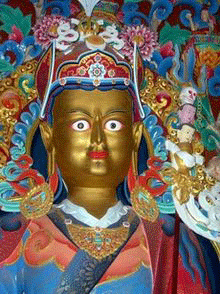Tibetan Buddhism is the body of Buddhist religious doctrine and institutions characteristic of Tibet and certain regions of the Himalayas, including northern Nepal, Bhutan, and India (particularly in Arunachal Pradesh, Ladakh, Dharamsala, Lahaul and Spiti in Himachal Pradesh, and Sikkim). It is also practiced in Mongolia and parts of Russia (Kalmykia, Buryatia, and Tuva) and Northeast China.
It includes the teachings of the three vehicles of Buddhism: the Foundational Vehicle, Mahayana, and Vajrayana.
In the wake of the 1959 Tibetan uprising, a Tibetan diaspora has made Tibetan Buddhism more widely accessible to the rest of the world. Tibetan Buddhism has since spread to many Western countries, where the tradition has gained popularity.
Buddhahood

Buddhahood is defined as a state free of the obstructions to liberation as well as those to omniscience. When, in Buddhahood, one is freed from all mental obscurations,one is said to attain a state of continuous bliss mixed with a simultaneous cognition of emptiness, the true nature of reality. In this state, all limitations on one’s ability to help other living beings are removed.
It is said that there are countless beings who have attained Buddhahood.Buddhas spontaneously, naturally and continuously perform activities to benefit all sentient beings. However it is believed that sentient beings’ karmas limit the ability of the Buddhas to help them. Thus, although Buddhas possess no limitation from their side on their ability to help others, sentient beings continue to experience suffering as a result of the limitations of their own former negative actions.
Schools
Tibetan Buddhism comprises many distinct schools, but is primarily divided into four main traditions: Nyingma, Kagyu, Gelug, and Sakya. All schools categorize their teachings into three “vehicles”:Hinayana, Mahayana, and Vajrayana, although some schools, the Gelug for example, consider Vajrayana a part of Mahayana. The Nyingma tradition classifies the corpus of Buddhist teachings into Nine Yanas, among the highest of which is known as Atiyoga or Dzogchen (Great Perfection).
Tibetan Buddhism has four main traditions:
– Nyingma(pa), The Ancient Ones. This is the oldest, the original order founded by Padmasambhava. Hidden treasures (terma) are of particular significance to the Nyingma tradition.
– Kagyu(pa), Lineage of the (Buddha’s) Word. This contains one major subsect and one minor subsect. The first, the Dagpo Kagyu, encompasses those Kagyu schools that trace back to Gampopa. In turn, the Dagpo Kagyu consists of four major sub-sects: the Karma Kagyu, headed by a Karmapa, the Tsalpa Kagyu, the Barom Kagyu, and Pagtru Kagyu. There are further eight minor sub-sects, all of which trace their root to Pagtru Kagyu. Among the eight sub-sects the most notable of are the Drikung Kagyu and the Drukpa Kagyu. The once-obscure Shangpa Kagyu, which was famously represented by the 20th century teacher Kalu Rinpoche, traces its history back to the Indian master Niguma, sister of Kagyu lineage holder Naropa. This is an oral tradition which is very much concerned with the experiential dimension of meditation. Its most famous exponent was Milarepa, an eleventh century mystic.
– Sakya(pa), Grey Earth, headed by the Sakya Trizin, this tradition was founded by Khon Konchog Gyalpo, a disciple of the great translator Drokmi Lotsawa. Sakya Pandita 1182–1251CE was the great grandson of Khon Konchog Gyalpo. This school very much represents the scholarly tradition.
– Gelug(pa), Way of Virtue, whose spiritual head is the Ganden Tripa and whose temporal head is the Dalai Lama. Successive Dalai Lamas ruled Tibet from the mid-17th to mid-20th centuries. This order was founded in the 14th to 15th century by Je Tsongkhapa, based on the foundations of the Kadampa tradition. Tsongkhapa was renowned for both his scholasticism and his virtue. The Dalai Lama belongs to the Gelugpa school, and is regarded as the embodiment of the Bodhisattva of Compassion.
Wikipedia




